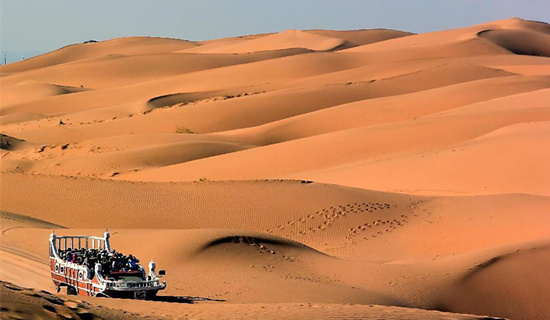By Tom McGregor, CCTV.com Panview commentator and editor
More than a decade ago, massive sandstorms had swept across northern China blowing eastward to strike the Korean Peninsula and Japan.
Sandstorms regularly blew in the spring months - March and April - causing significant inconveniences for residents of Beijing, Seoul and Tokyo. The air transformed into a yellow dust that could cause health problems for the young and old.
Sand particles when inhaled can inflict respiratory ailments that are potentially life-threatening for infants, asthmatics and the elderly. As China's deserts expanded, the sandstorms had gotten more widespread and dangerous.
Accordingly at the turn of this century, the Chinese Central Government jump-started "Green Wall of China" projects, by spending RMB billion to transform deserts into green spaces.
Kubuqi Desert goes green
A shining example of success for China's desertification can be witnessed aqt the Kubuqi Desert, the seventh largest desert in the nation.

Kubuqi Desert
The desert had covered over 18,600-sq./km. of territory in the Ordos area of Inner Mongolia Autonomous Region. Greening more than 6,000-sq./km. of Kubuqi had started about three decades ago.
Now that a 1/3 of the land is no longer a desert, over 102,000 people in the region were lifted out of poverty. Farmers, shepherds and ranchers had planted Chinese medicinal herbals, such as licorice to prevent soil erosion.
Local government officials, scientists and business people had also constructed a photovoltaic power station for electricity and utilized sustainable business models to promote eco-tourism.
The strategy had integrated government policy instruments, private sector investment and active participation of the local community, according to the United Nations Environment Program (UNEP).
Meeting for continued progress
On July 28-30, the 6th Kubuqi International Desert Forum was held with over 300 stakeholders from 30 countries in attendance, as they convened at the Kubuqi International Convention Center.
Chinese Vice Premier Ma Kai delivered the keynote address to highlight Beijing’s achievements. Ma noted China is the first country to make sizable reductions of its desert territory.
At the end of the 20th Century, China's deserts were expanding at a pace - 10,000-sq./km. per year, but in recent years, deserts are shrinking about 2,400-sq./km. annually.
In China's 5-year plan (2016-2020), Beijing set a target to convert 10 million hectares of desert into green land. China has coordinated with the UN - UNEP and UN Convention to Combat Desertification.
Chinese President Xi Jinping has also called for member states of the Belt & Road Initiative to sign up for desertification projects.
Tapping companies for forestation
The best method to decrease desert lands would be to encourage local people to find ways to generate income from such efforts. The company Elion Resources Group ERG), serves an advisory role in the Kubuqi desertification project.
"Using innovative technologies, ten times more efficient than traditional methods, Elion has been able to cultivate over 1,000 cold restant, drought enduring and saline tolerant plant seeds," Cameroon Tribune quotes an Eliot Resources Group press release as saying.
ERG added, "It has also initiated an ecological photovoltaic industry that integrates desertification control, power generation, plantation agriculture, animal husbandry and poverty alleviation."
The firm had developed the 'Kubuqi Model' for "building a desert ecological-economy demonstration zone to help China and the world meet UN Sustainable Development Goals by 2030.
The Chinese Ministry of Science and Technology, Chinese State Forestry Administration and the government of Inner Mongolia have formed partnerships to create green deserts.
Keeping Gobi Desert in check
Over a decade ago, Chinese officials started to focus on the Gobi Desert, which was gobbling up more than 3,600-sq./km. per year. The State Forestry Administration (SFA) has played a crucial role.
The SFA launched projects in Western China's Ningxia Province to create forests in the region while coordinating with UN agencies. They have achieved remarkable results.
"First, that the restoration of even a severely degraded world is possible," Luc Gnacadja, former executive secretary of UN Convention of Combat Desertification told AlJazeera in 2012. "Second, that the government - creating the right policy incentives - is indispensable."
He added, "third, is that we must think outside our traditional boxes, regarding land stewardship - how we value money and invest in it."
Living the 'Sand Warrior' spirit
Another prominent figure in China's desertification campaign is Wang Youde, who has spent over 32 years in Ningxia to prevent Maowusu desert from spreading south and west.
He's been hailed by many Chinese and dubbed, "Warrior of the Sands."
"I think we have realized our goal," said Wang. "We made the place lively and better and we made the desert green. We have also made ourselves a better life."
Warrior Wang has gotten to the crux of the matter. For China's desertification actions to win stronger appeal, the Chinese must recognize its value and pragmatism.
Turning deserts into green spaces is not just an eco-friendly endeavor, but offers opportunities for locals to generate higher household incomes and to live a happier lifestyle when fighting against the sandstorm menace.







